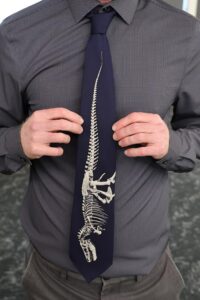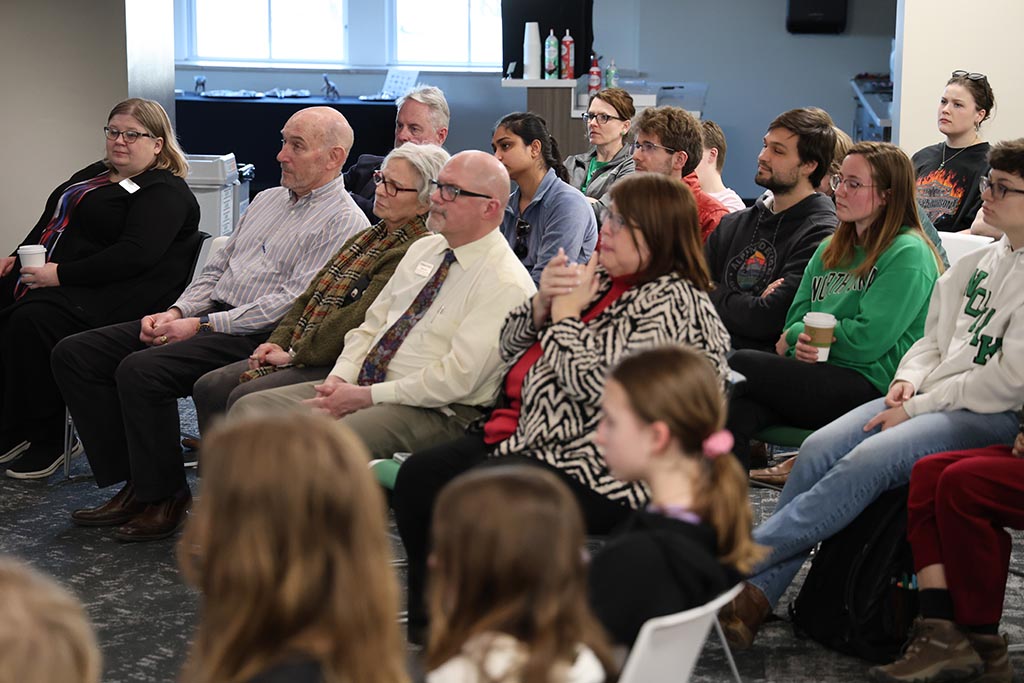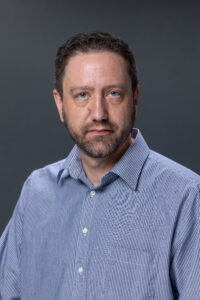‘Jurassic Park’: No. ‘Pleistocene Park’: Maybe?
While dinosaur DNA remains unrecoverable, molecular paleontology still has come a long way, a UND geologist says

“Where do you get 100-million-year-old dinosaur blood?” asks Laura Dern, acting in the 1993 blockbuster “Jurassic Park.”
The film answered that question shortly thereafter with a scene that many will recall: A large bead of amber with a prehistoric mosquito inside – which a lab technician subsequently drills into to extract the ancient blood.
An ingenious concept for a movie. But does it actually work? Do prehistoric proteins and DNA exist, and if they do, what can be done with them? What do they tell us about the past, and, perhaps, the future? Are we going to … clone something?
Those were the questions that Paul Ullman, assistant professor of Geology and Geological Engineering, discussed on April 3, when he took part in the fourth installment of the Randy Rasmussen Memorial Lecture Series, held in the Chester Fritz Library. His talk? Dinosaur Molecules: Exploring how soft tissues and biologic molecules can persist in dinosaur bones.
Ullmann, who specializes in vertebrate paleontology and the fossilization processes, is conducting research in an area of study called molecular paleontology, where researchers recover and analyze prehistoric biological material.
And he isn’t big on the amber-preserving-DNA idea (though it seems he liked the movie). While the hardened ancient tree sap does preserve wonderful fossils, it desiccates whatever is inside, right down to the DNA, leaving nothing recoverable.
“I have to say, that would never work,” Ullmann said to laughter. “I hate to ruin a great movie, but it’s not a great place for molecular preservation.”
But Ullmann isn’t looking to build a living dinosaur park where mayhem seems inevitable. Instead, his research can shed light on the process of molecular preservation, and perhaps give researchers an insight into how molecules will evolve in the future. He has been working on showing the presence in dinosaur fossils of not DNA, but other biologic molecules — specifically collagen, a structural protein found in, among other places, bones.
Bone, he said, is a porous material that contains an entire matrix of proteins, fats, carbohydrates and other biologic molecules – molecules that can survive through the fossilization process, a notion that paleontologists didn’t come to accept until recently.

To find these collagen proteins, he must do the seemingly unthinkable: break open a fossilized dinosaur bone. After placing a section of that bone on a microscope slide, he adds to it disease-fighting antibodies, the same found in every human on the planet. These antibodies bind to any protein in the fossil, just as they would to an invading virus in a body.
A second dose of antibodies binds to the first, and the application of a detection liquid, which fluoresces under certain wavelengths of light, reveals the presence of collagen proteins.
He still regrets breaking the bones open, though.
“Most paleontologists would say ‘What are you doing?’” he said. “To hunt for molecules, to hunt for the soft tissues in dinosaur bones, we have to break them a little bit.”
Ullmann isn’t alone in his quest to better understand prehistoric molecules. In different labs with different equipment and different reagents, other researchers across the nation are finding similar results as his, and it’s this reproduction of those results that Ullmann says is the gold standard of scientific inquiry.
“That’s about as good as it gets for evidence,” he said.
Possible medical applications
If one doesn’t wish to build a theme park of easily escapable dinosaur enclosures, why isolate these proteins?
Ullmann admits that the “resurrection idea” is the first to come to mind, but he’s thinking about other possibilities.
For instance, studying ancient biologic molecules can lead to a better understanding of similar molecules in existence today. How are they put together, what are their weak points? The ancient protein molecules might shed light on certain diseases where proteins break down prematurely and impact the health of an organism.
“It’s a very real thing that studying molecular decay and fossils might someday yield useful information for medical applications,” Ullmann said.
And continuing to study these ancient molecules, from fossils that span millions of years in age, also will paint a picture of how they evolved, and might even yield a predictive model as to how they will continue to evolve in living creatures beyond today.
So … no cloning?
After previously delivering the truth about the extract-DNA-from-amber theory, Ullmann rekindled audience members’ hopes of one day building a ‘what could go wrong?’ dinosaur safari land.
In 2013, his colleagues in North Carolina used a specific dye, got a positive reaction from split-open dinosaur bones … and found DNA remnants, or at least shattered and at times unrecognizable pieces of them.
“Maybe there is hope for Jurassic Park after all,” Ullman said.
There is even more possibility of building a “Pleistocene Park” filled with woolly mammoths, seeing as how scientists are in possession of the creature’s complete genome. That’s thanks to the animal’s relative geologic youth (about 2.5 million years compared to a Jurassic creature’s age of almost 200 million years), and the discovery of well-preserved remains.
“No problem at all. We could really do that right now, if we wanted to,” Ullmann joked.
“In downtown Grand Forks?” suggested an audience member.
“Well, those are some ethical questions there, such as bringing back an ice-age creature in a warming world,” Ullmann replied with a smile.
Back at UND …
In addition to conducting his research, Ullmann has plans to expand paleontology education on campus. This fall, he will introduce Geology 112: Discovering Dinosaurs, a new course that will satisfy central studies requirements for all majors.
Ullmann also is working toward adding a paleontology concentration to UND’s Geology degree. And he’s remodeling a space in Leonard Hall to become a molecular paleo laboratory. The lab is needed to house specific equipment to discover those ancient biologic molecules and to keep them free of contaminants.
Ullmann said he also is seeking help from faculty, staff and members of the public in cleaning and stabilizing a new dinosaur skeleton he brought to UND. Information about volunteering for that project can be found on the College of Engineering & Mine’s website.




